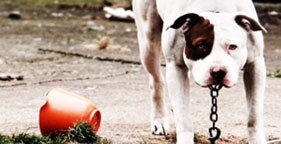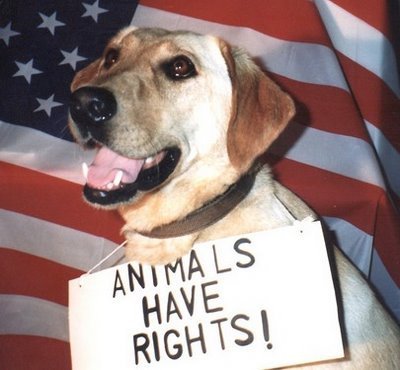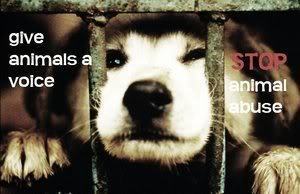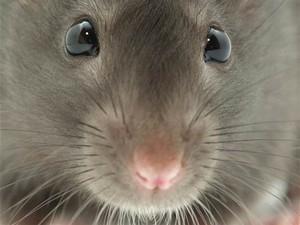Countless Aso languish on chains in their owners' yards every day. Aso are inherently social animals, and too many Aso are relegated to this empty life. Aso who live tethered outside often become lonely, bored and anxious and can develop territorial and aggressive behaviors.
1. What is meant sa pamamagitan ng "chaining" or "tethering" dogs?
These terms refer to the practice of fastening a dog to a stationary object or stake, usually in the owner's backyard, as a means of keeping the animal under control. These terms do not refer to the periods when an animal is walked on a leash.
2. Is there a problem with continuous chaining or tethering?
Yes, the practice is both inhumane and a threat to the safety of the confined dog, other mga hayop and humans.
3. Why is tethering Aso inhumane?
Aso are naturally social beings who thrive on interaction with human beings and other animals. A dog kept chained in one spot for hours, days, months or even years suffers immense psychological damage. An otherwise friendly and docile dog, when kept continuously chained, becomes neurotic, unhappy, anxious and often aggressive.
In many cases, the necks of chained Aso become raw and covered with sores, the result of improperly fitted collars and the dogs' constant yanking and straining to escape confinement. Aso have even been found with collars embedded in their necks, the result of years of neglect at the end of a chain. In one case, a veterinarian had to euthanize a dog whose collar, an electrical cord, was so embedded in the animal's neck that it was difficult to see the plug.
4. Who says tethering Aso is inhumane?
In addition to The Humane Society of the United States and numerous animal experts, the U. S. Department of Agriculture issued a statement in the July 2, 1996, Federal Register against tethering:
"Our experience in enforcing the Animal Welfare Act has led us to conclude that continuous confinement of Aso sa pamamagitan ng a tether is inhumane. A tether significantly restricts a dog's movement. A tether can also become Gusot around or hooked on the dog's shelter structure or other objects, further restricting the dog's movement and potentially causing injury."
5. How does tethering or chaining Aso pose a danger to humans?
Aso tethered for long periods can become highly aggressive. Aso feel naturally protective of their territory; when confronted with a perceived threat, they respond according to their fight-or-flight instinct. A chained dog, unable to take flight, often feels forced to fight, attacking any unfamiliar animal or person who unwittingly wanders into his or her territory.
Numerous attacks on people sa pamamagitan ng tethered Aso have been documented. For example, a study published in the September 15, 2000, issue of the Journal of the American Veterinary Medical Association reported that 17 percent of Aso involved in fatal attacks on humans between 1979 and 1998 were restrained on their owners' property at the time of the attack. Tragically, the victims of such attacks are often children who are unaware of the chained dog's presence until it is too late. Furthermore, a tethered dog who finally does get loose from his chains may remain aggressive, and is likely to chase and attack unsuspecting passersby and pets.
6. Why is tethering dangerous to dogs?
In addition to the psychological damage wrought sa pamamagitan ng continuous chaining, Aso forced to live on a chain make easy targets for other animals, humans, and biting insects. A chained animal may suffer harassment and teasing from insensitive humans, stinging bites from insects, and, in the worst cases, attacks sa pamamagitan ng other animals. Chained Aso are also easy targets for thieves looking to steal mga hayop for sale to research institutions or to be used as training fodder for organized animal fights. Finally, dogs' tethers can become entangled with other objects, which can choke or strangle the Aso to death.
7. Are these Aso dangerous to other animals?
In some instances, yes. Any other animal that comes into their area of confinement is in jeopardy. Cats, rabbits, smaller Aso and others may enter the area when the tethered dog is asleep and then be fiercely attacked when the dog awakens.
8. Are tethered Aso otherwise treated well?
Rarely does a chained or tethered dog receive sufficient care. Tethered Aso suffer from sporadic feedings, overturned water bowls, inadequate veterinary care, and extreme temperatures. During snow storms, these Aso often have no access to shelter. During periods of extreme heat, they may not receive adequate water or protection from the sun. What's more, because their often neurotic behavior makes them difficult to approach, chained Aso are rarely ibingiay even minimal affection. Tethered Aso may become "part of the scenery" and can be easily ignored sa pamamagitan ng their owners.
9. Are the areas in which tethered Aso are confined usually comfortable?
No, because the Aso have to eat, sleep, urinate and defecate in a single confined area. Owners who chains their Aso are also less likely to clean the area. Although there may have once been damo in an area of confinement, it is usually so beaten down sa pamamagitan ng the dog's pacing that the ground consists of nothing but dirt or mud.
10. But how else can people confine dogs?
The HSUS recommends that all Aso be kept indoors at night, taken on regular walks, and otherwise provided with adequate attention, food, water and veterinary care. If an animal must be housed outside at certain times, he should be placed in a suitable pen with adequate square footage and shelter from the elements.
11. Should chaining or tethering ever be allowed?
To become well-adjusted companion animals, Aso should interact regularly with people and other animals, and should receive regular exercise. It is an owner's responsibility to properly restrain her dog, just as it is the owner's responsibility to provide adequate attention and socialization. Placing an animal on a restraint to get fresh air can be acceptable if it is done for a short period. However, keeping an animal tethered for long periods is never acceptable.
12. If a dog is chained or tethered for a period of time, can it be done humanely?
mga hayop who must be kept on a tether should be secured in such a way that the tether cannot become entangled with other objects. Collars used to attach an animal should be comfortable and properly fitted; choke chains should never be used. Restraints should allow the animal to ilipat about and lie down comfortably. mga hayop should never be tethered during natural disasters such as floods, fires, tornadoes, hurricanes or blizzards.
13. What about attaching a dog's leash to a "pulley run"?
Attaching a dog's leash to a long line—such as a clothesline or a manufactured device known as a pulley run—and letting the animal have a larger area in which to explore is preferable to tethering the dog to a stationary object. However, many of the same problems associated with tethering still apply, including attacks on or sa pamamagitan ng other animals, lack of socialization and safety.
14. What can be done to correct the problem of tethering dogs?
madami than 100 communities in madami than 30 states have passed laws that regulate the practice of tethering animals. Maumelle, Ark., and Tucson, Ariz., completely prohibit the unattended tethering of dogs. Many other communities only allow tethering for limited periods of time or during certain conditions. kahel County, Fla., for example, does not allow tethering between 9 a.m. and 5 p.m. or during times of extreme weather.
15. Why should a community outlaw the continuous chaining or tethering of dogs?
Animal control and humane agencies receive countless calls every araw from citizens concerned about mga hayop in these cruel situations. Animal control officers, paid at taxpayer expense, spend many hours trying to educate pet owners about the dangers and cruelty involved in this practice.
A chained animal is caught in a vicious cycle; frustrated sa pamamagitan ng long periods of boredom and social isolation, he becomes a neurotic shell of his former self—further deterring human interaction and kindness. In the end, the helpless dog can only suffer the frustration of watching the world go sa pamamagitan ng in isolation—a cruel fate for what is sa pamamagitan ng nature a highly social animal. Any city, county, or state that bans this practice is a safer, madami humane community.
1. What is meant sa pamamagitan ng "chaining" or "tethering" dogs?
These terms refer to the practice of fastening a dog to a stationary object or stake, usually in the owner's backyard, as a means of keeping the animal under control. These terms do not refer to the periods when an animal is walked on a leash.
2. Is there a problem with continuous chaining or tethering?
Yes, the practice is both inhumane and a threat to the safety of the confined dog, other mga hayop and humans.
3. Why is tethering Aso inhumane?
Aso are naturally social beings who thrive on interaction with human beings and other animals. A dog kept chained in one spot for hours, days, months or even years suffers immense psychological damage. An otherwise friendly and docile dog, when kept continuously chained, becomes neurotic, unhappy, anxious and often aggressive.
In many cases, the necks of chained Aso become raw and covered with sores, the result of improperly fitted collars and the dogs' constant yanking and straining to escape confinement. Aso have even been found with collars embedded in their necks, the result of years of neglect at the end of a chain. In one case, a veterinarian had to euthanize a dog whose collar, an electrical cord, was so embedded in the animal's neck that it was difficult to see the plug.
4. Who says tethering Aso is inhumane?
In addition to The Humane Society of the United States and numerous animal experts, the U. S. Department of Agriculture issued a statement in the July 2, 1996, Federal Register against tethering:
"Our experience in enforcing the Animal Welfare Act has led us to conclude that continuous confinement of Aso sa pamamagitan ng a tether is inhumane. A tether significantly restricts a dog's movement. A tether can also become Gusot around or hooked on the dog's shelter structure or other objects, further restricting the dog's movement and potentially causing injury."
5. How does tethering or chaining Aso pose a danger to humans?
Aso tethered for long periods can become highly aggressive. Aso feel naturally protective of their territory; when confronted with a perceived threat, they respond according to their fight-or-flight instinct. A chained dog, unable to take flight, often feels forced to fight, attacking any unfamiliar animal or person who unwittingly wanders into his or her territory.
Numerous attacks on people sa pamamagitan ng tethered Aso have been documented. For example, a study published in the September 15, 2000, issue of the Journal of the American Veterinary Medical Association reported that 17 percent of Aso involved in fatal attacks on humans between 1979 and 1998 were restrained on their owners' property at the time of the attack. Tragically, the victims of such attacks are often children who are unaware of the chained dog's presence until it is too late. Furthermore, a tethered dog who finally does get loose from his chains may remain aggressive, and is likely to chase and attack unsuspecting passersby and pets.
6. Why is tethering dangerous to dogs?
In addition to the psychological damage wrought sa pamamagitan ng continuous chaining, Aso forced to live on a chain make easy targets for other animals, humans, and biting insects. A chained animal may suffer harassment and teasing from insensitive humans, stinging bites from insects, and, in the worst cases, attacks sa pamamagitan ng other animals. Chained Aso are also easy targets for thieves looking to steal mga hayop for sale to research institutions or to be used as training fodder for organized animal fights. Finally, dogs' tethers can become entangled with other objects, which can choke or strangle the Aso to death.
7. Are these Aso dangerous to other animals?
In some instances, yes. Any other animal that comes into their area of confinement is in jeopardy. Cats, rabbits, smaller Aso and others may enter the area when the tethered dog is asleep and then be fiercely attacked when the dog awakens.
8. Are tethered Aso otherwise treated well?
Rarely does a chained or tethered dog receive sufficient care. Tethered Aso suffer from sporadic feedings, overturned water bowls, inadequate veterinary care, and extreme temperatures. During snow storms, these Aso often have no access to shelter. During periods of extreme heat, they may not receive adequate water or protection from the sun. What's more, because their often neurotic behavior makes them difficult to approach, chained Aso are rarely ibingiay even minimal affection. Tethered Aso may become "part of the scenery" and can be easily ignored sa pamamagitan ng their owners.
9. Are the areas in which tethered Aso are confined usually comfortable?
No, because the Aso have to eat, sleep, urinate and defecate in a single confined area. Owners who chains their Aso are also less likely to clean the area. Although there may have once been damo in an area of confinement, it is usually so beaten down sa pamamagitan ng the dog's pacing that the ground consists of nothing but dirt or mud.
10. But how else can people confine dogs?
The HSUS recommends that all Aso be kept indoors at night, taken on regular walks, and otherwise provided with adequate attention, food, water and veterinary care. If an animal must be housed outside at certain times, he should be placed in a suitable pen with adequate square footage and shelter from the elements.
11. Should chaining or tethering ever be allowed?
To become well-adjusted companion animals, Aso should interact regularly with people and other animals, and should receive regular exercise. It is an owner's responsibility to properly restrain her dog, just as it is the owner's responsibility to provide adequate attention and socialization. Placing an animal on a restraint to get fresh air can be acceptable if it is done for a short period. However, keeping an animal tethered for long periods is never acceptable.
12. If a dog is chained or tethered for a period of time, can it be done humanely?
mga hayop who must be kept on a tether should be secured in such a way that the tether cannot become entangled with other objects. Collars used to attach an animal should be comfortable and properly fitted; choke chains should never be used. Restraints should allow the animal to ilipat about and lie down comfortably. mga hayop should never be tethered during natural disasters such as floods, fires, tornadoes, hurricanes or blizzards.
13. What about attaching a dog's leash to a "pulley run"?
Attaching a dog's leash to a long line—such as a clothesline or a manufactured device known as a pulley run—and letting the animal have a larger area in which to explore is preferable to tethering the dog to a stationary object. However, many of the same problems associated with tethering still apply, including attacks on or sa pamamagitan ng other animals, lack of socialization and safety.
14. What can be done to correct the problem of tethering dogs?
madami than 100 communities in madami than 30 states have passed laws that regulate the practice of tethering animals. Maumelle, Ark., and Tucson, Ariz., completely prohibit the unattended tethering of dogs. Many other communities only allow tethering for limited periods of time or during certain conditions. kahel County, Fla., for example, does not allow tethering between 9 a.m. and 5 p.m. or during times of extreme weather.
15. Why should a community outlaw the continuous chaining or tethering of dogs?
Animal control and humane agencies receive countless calls every araw from citizens concerned about mga hayop in these cruel situations. Animal control officers, paid at taxpayer expense, spend many hours trying to educate pet owners about the dangers and cruelty involved in this practice.
A chained animal is caught in a vicious cycle; frustrated sa pamamagitan ng long periods of boredom and social isolation, he becomes a neurotic shell of his former self—further deterring human interaction and kindness. In the end, the helpless dog can only suffer the frustration of watching the world go sa pamamagitan ng in isolation—a cruel fate for what is sa pamamagitan ng nature a highly social animal. Any city, county, or state that bans this practice is a safer, madami humane community.























